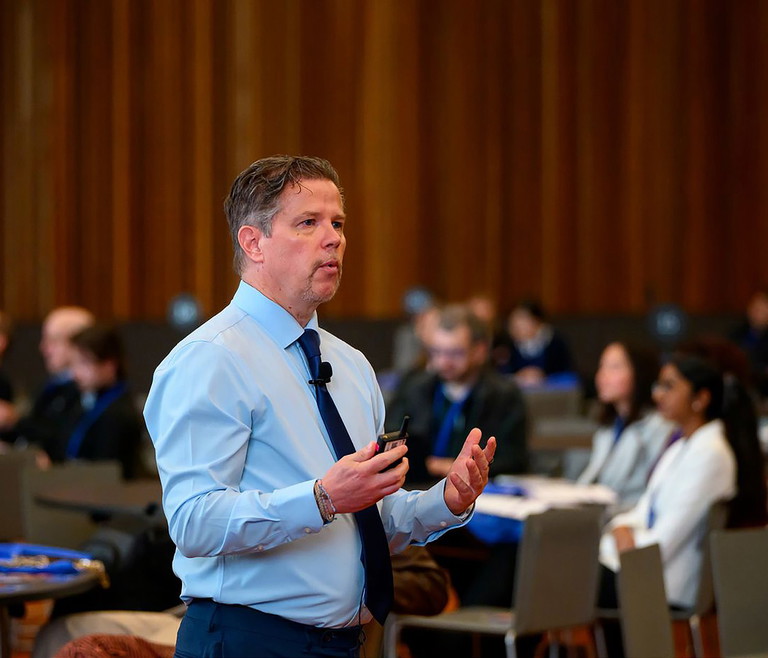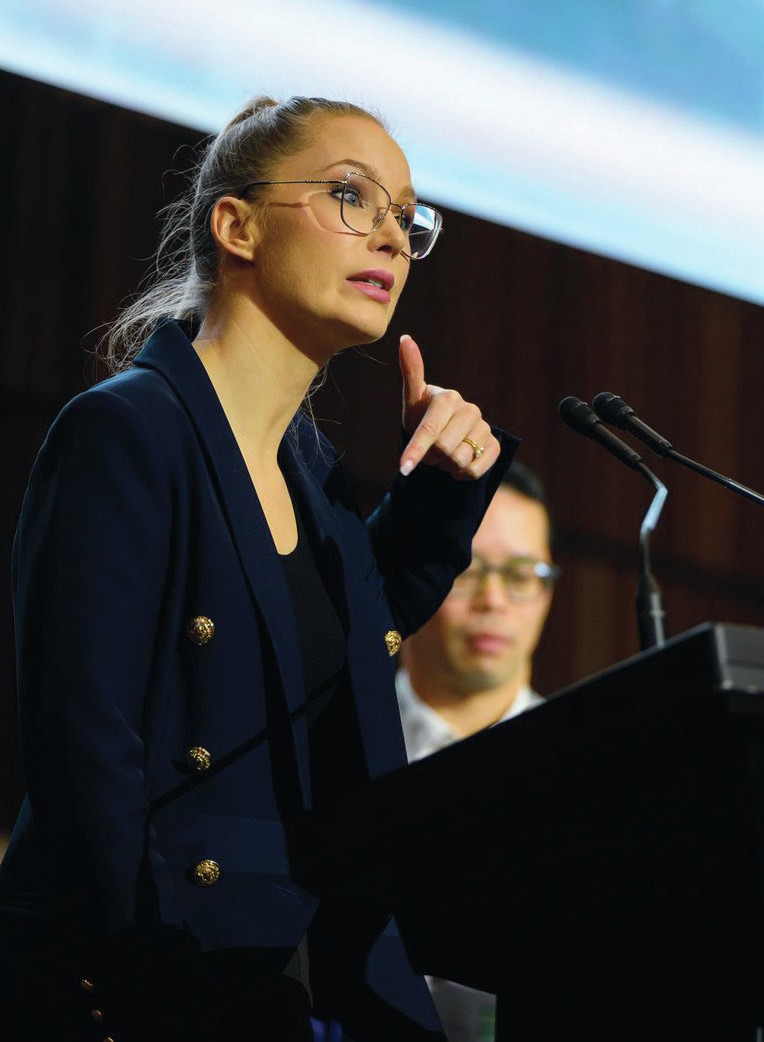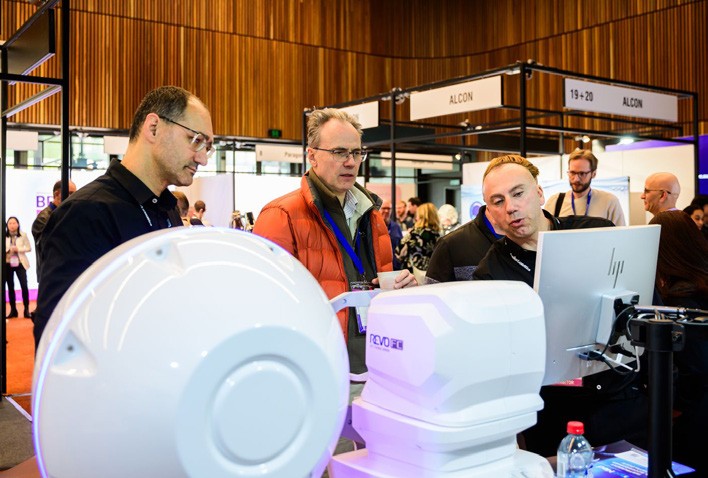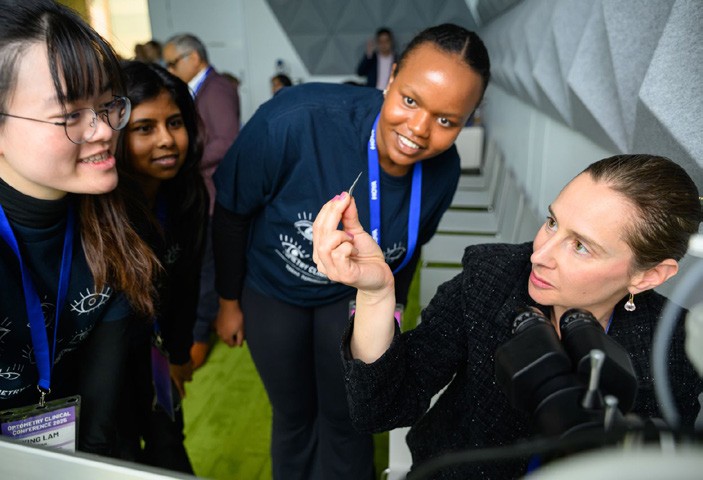mievent
Embracing Face-to-Face
Optometry’s National Clinical Conference
WRITER Melanie Kell

Professor Blair Lonsberry

Dr Anne Weymouth
If you’re inclined to suffer from FOMO (fear of missing out) you may not wish to read on. Because the recent Optometry Clinical Conference, held at Centrepiece on the fringe of Melbourne’s central business district, was an outstanding success.
Hosted by Optometry Australia in partnership with its counterparts in Victoria, Tasmania, Queensland, Northern Territory, and South Australia, this face-to-face meeting brought optometrists together from around the country.
Lectures, workshops, trade displays, and a cocktail party complete with pub choir, rounded out the event. And with smiles, exclamations of surprise, and people embracing wherever I walked, it was clear that there will always be a place for live events like this one.
WRITER Melanie Kell
PHOTOS Francesco Vicenzi
A NEUROSCIENTIST’S GUIDE TO UNDERSTANDING STRESS
With 31% of Australian optometrists reporting depression, anxiety, and/or moderate to severe psychological distress; and 56% reporting high burnout,1 it was no surprise that Optometry Australia kicked off its two-day conference with a presentation by Tasmanian neuroscientist Dr Lila Landowski on stress management.
Dr Landowski explained that the brain’s primary function is survival, and stress triggers a hardwired physiological response designed to help us cope with immediate threats. When stressed, the sympathetic nervous system releases hormones that increase heart rate, dilate airways, and redirect blood flow to essential organs. This response is beneficial in the short term, improving performance and memory while priming the immune system.
However, modern workplace stressors – patient demands, regulatory pressures, financial concerns – trigger this same survival mechanism repeatedly throughout the day, leading to chronic stress when the response cannot switch off.
Long-term Consequences
Chronic stress physically alters brain structure, Dr Landowski told the audience. The amygdala, responsible for emotional processing, enlarges and becomes hyperreactive, leading to increased aggression and irritability. Simultaneously, the prefrontal cortex – governing decision making, attention, and empathy – shrinks and disconnects from other brain regions. The hippocampus, crucial for learning and memory, also deteriorates, resulting in memory issues and reduced adaptability.
These changes explain why chronically stressed optometrists may struggle with patient interactions, experience brain fog, make poor decisions, or feel unable to see situations from others’ perspectives.
Evidence-Based Solutions
Dr Landowski said understanding that stress responses are physiological rather than personal failings, can enable optometrists to implement targeted strategies, ultimately protecting both professional wellbeing and patient care quality.
She outlined practical interventions to activate the parasympathetic nervous system and counter chronic stress. Regular exercise for 150 minutes weekly demonstrates significant benefits after just two weeks. The “physiological sigh” – two inhales followed by a long exhale – provides immediate stress relief by decreasing the heart rate within 30 seconds.
Social connection remains vital, with face-to-face interactions more beneficial than digital communication. Spending 20 minutes in green spaces reduces cortisol by 20%, while gratitude practices and 13 minutes of daily meditation can reverse stress-related brain changes.
EVOLVING WITH SCOPE EXPANSION
Another pressing issue for optometry is expansion of the scope of practice to meet the needs of our growing ageing population.
With this in mind, Professor Blair Lonsberry, who practises in the United States, traced optometry’s evolution from spectacle-making guilds circa 1300, to modern therapeutic practice, with a focus on Australia’s progressive regulatory history. Tasmania pioneered optometry registration in 1913, with therapeutic prescribing arriving in Victoria by 2000, establishing Australia as an early adopter of expanded scope.
However, the US has moved ahead on this front with optometrists performing injections in 20 US States, and laser privileges available in 14 States.
Prof Lonsberry said optometrists “continue to strive to expand our scope of practice, not because of ego but because it’s for our patients”. His clinical demonstrations of YAG capsulotomy, selective laser trabeculoplasty, and chalazion injections illustrated the impact of appropriately trained optometrists with access to these advanced procedures in the US.
Australian optometrists aren’t “less capable” than their US counterparts, he told the audience, they’re simply restricted by current regulations. “I can guarantee every one of you can do exactly what I do in the States. You’re just not given the chance.”
With ophthalmology facing workforce shortages and an ageing population increasing demand, he said Australian optometrists must advocate for expanded therapeutic privileges. Doing so will ensure more patients can access the professional eye care services they need, and outcomes can be improved.
NZ’s Oral Prescribing Success Story
In a separate lecture, New Zealand hospital-based optometrist Richard Johnson shared 11 years of real-world data on oral therapeutic prescribing in NZ. Initially adopted slowly, oral prescribing has experienced recent significant growth, with optometrists now writing approximately 9,000 prescriptions monthly – of which approximately 5% are for oral medications.
Mr Johnson’s data demonstrated exceptional safety, with no reported adverse events since becoming authorised prescribers in 2014, reflecting optometry’s inherently conservative and safe prescribing approach. The evidence showed NZ optometrists prescribe appropriately, consulting colleagues when needed and following evidence-based protocols.
Mr Johnson said the patient benefits are substantial: improved accessibility, reduced hospital referrals, and elimination of multiple appointments requiring time off work, parking costs, and support person accompaniment. For optometrists, oral prescribing enhances clinical capabilities, strengthens professional relationships with general practitioners, and demonstrates expanded scope to other healthcare professionals.
MYOPIA: FROM SYNDROME RECOGNITION TO TREATMENT STRATEGIES
During an engaging presentation by Sydney ophthalmologist Dr Craig Donaldson with optometrist Heidi Hunter (Newcastle) and Soojin Nam (Sydney), the audience was challenged to recognise myopia’s broader spectrum beyond simple refractive error.
Having distinguished between high myopia, pathological myopia, and syndromic myopia, Dr Donaldson reminded the audience that pathological changes can occur, even with moderate myopia, but affect 50–70% of high myopes. To illustrate myopia’s prevalence, he reflected on a recent Coldplay concert he attended. Given the prevalence of myopia, he said it occurred to him that 2,000–3,000 of the 80,000-strong audience were likely to have had high myopia. Crucially, children under 10 with high myopia have a 40% risk of underlying systemic conditions, including Stickler syndrome and Marfan syndrome. These connective tissue disorders require urgent medical attention due to associated cardiac risks, positioning optometrists as potential first-line detectors.
Ms Hunter spoke about how her practice optimises myopia outcomes by systematically monitoring patients using specialised software. This allows treatment modifications to be based on efficacy data. The case study of nine-year-old Jane White* demonstrated this approach. Jane, who initially presented with low hyperopic reserve (+0.50D) and long axial length (23 mm) at age six, was identified as a pre-myope. Treatment under her ophthalmologist commenced with atropine therapy, achieving 15% efficacy. Later under co-management with Ms Hunter, Jane progressed to combination therapy with defocus incorporated multiple segment (DIMS) lenses reaching 71% efficacy, illustrating the power of dual approaches.
Optometrist Soojin Nam addressed myopia of prematurity – a refractive error that develops in infants born prematurely – highlighting Australia’s 8.7% preterm birth rate. Her case study of twins born at 23 weeks demonstrated unique management challenges, where myopia progression differs significantly from school-age onset. With limited evidence for this population, she advocated case-by-case clinical judgment in co-management with ophthalmologists. Ms Nam noted that the International Myopia Institute will soon publish a paper on myopia prematurity, which will build on established knowledge.
GEOGRAPHIC ATROPHY: A NEW TREATMENT ERA
Professor Robyn Guymer AM, from the Centre for Eye Research Australia, spoke about the first approved treatments now available for geographic atrophy (GA). The Therapeutic Goods Administration approved pegcetacoplan (Syfovre, Apellis) in 2024, though any Pharmaceutical Benefits Scheme (PBS) listing remains pending, while a second treatment, avacincaptad pegol (Izervay, Astellas) awaits Australian approval.
Both treatments target the complement inflammatory pathway, with studies demonstrating that GA lesion growth slowed by approximately 20% over two years.2 However, with these treatments, growth of the atrophy is slowed, but will still increase over time, so the aim is to preserve the central foveal area and visual acuity for as long as possible. The OAKS and DERBY trials demonstrated anatomical preservation with post-hoc analyses suggesting functional benefits, including 38% reduction in severe vision loss risk.2 However, safety concerns include increased development of neovascular age-related macular degeneration (nAMD). Additionally, while never seen in clinical trials, rare but devastating occlusive vasculitis has been reported in 20 cases, about 1:8,000 at their first injection, with 12 cases losing six lines of vision following this potentially blinding complication.
Unlike nAMD management, GA treatment requires individualised patient selection, considering factors including lesion location, progression rate, and patient circumstances. Without PBS listing, treatment with Syfovre costs AU$3,300 per injection to buy every eight weeks per eye, limiting current accessibility.

Dr Lila Landowski

Delegates explore the tradeshow.

Teaching foreign body removal.
Prof Guymer recommended preparing for availability of these treatments with baseline optical coherence tomography (OCT) imaging and fundus autofluorescent imaging if available, to identify early atrophic signs and monitor progression rates. She said learning to recognise the early OCT signs of atrophy, such as nascent GA, complete retinal pigment epithelium, and outer retinal atrophy on OCT, is important as this will change the conversation with the patient, as eye health professionals move forward with the ability to treat atrophy.
Turning to other GA treatments in the pipeline, she said red light photobiomodulation therapy had received device approval by the United States Food and Drug Administration (FDA), though evidence of efficacy remains very limited. Multiple treatments, including gene therapy and cell replacement therapies, are advancing through trials, suggesting further therapeutic expansion ahead.
“Ms Wilcox, who lives with cerebral palsy, shared her personal experiences including practitioners speaking to carers instead of herself, using patronising language, and making assumptions based on communication differences”
NAVIGATING COMPLEX OCCUPATIONAL DRIVING STANDARDS
Melbourne University’s Dr Anne Weymouth addressed the intricate landscape of occupational driving standards, highlighting significant variations across Australian states that create challenges for practitioners.
Optometrists, she said, play a crucial role as gatekeepers for public safety while managing complex regulatory requirements.
For commercial driving licences, drivers require 6/9 visual acuity with fellow eye no worse than 6/18, alongside normal visual fields extending 140° horizontally. However, conditional licences may be granted with careful assessment and monitoring schedules. Dr Weymouth stressed that confrontation testing suffices when no ocular disease is suspected, but automated static perimetry becomes mandatory if clinical suspicion exists.
The regulatory complexity extends beyond standard driving licences. Emergency service workers operate outside normal road rules, requiring enhanced visual processing capabilities and often stricter standards. Aviation demands Class One medicals for commercial pilots, including colour vision testing through Ishihara screening and specialised lantern tests. Railway, maritime, and defence force positions each impose specific visual requirements, while construction and mining industries maintain their own standards.
Dr Weymouth reminded optometrists of their responsibility to communicate honestly with patients about their visual status and its implications for licensing. Different states mandate varying reporting requirements, with some requiring mandatory notification of commercial drivers who fail to meet standards. The medicolegal implications necessitate thorough documentation and appropriate test selection based on clinical indicators rather than defensive practice.
SUPPORTING PATIENT DECISION MAKING
Tallia Salli and Michelle Wilcox from the Victorian Office of the Public Advocate addressed the crucial topic of supporting healthcare decisions for patients with disabilities. Their presentation, part of a six-year federally funded project, emphasised that all patients deserve the right to participate actively in their healthcare decisions with appropriate support.
Ms Salli, a psychologist with lived experience of acquired brain injury, stressed that supportive decision making differs fundamentally from substitute decision making. Rather than making assumptions about capacity, practitioners should provide information in accessible formats, allow adequate time for processing, and communicate directly with patients rather than their support persons.
Ms Wilcox, who lives with cerebral palsy, shared her personal experiences including practitioners speaking to carers instead of herself, using patronising language, and making assumptions based on communication differences. Key principles include using plain language, making reasonable environmental adjustments, explaining procedures beforehand, and respecting patient autonomy.
This approach has been integrated into university curricula, reflecting growing recognition of disability rights in healthcare settings.
WORKSHOPS AND PRACTICAL SKILLS DEVELOPMENT
The conference featured several workshops designed to enhance practical clinical skills and introduce cutting-edge technologies.
At a session on dry eye disease, Scientia Professor Fiona Stapleton from the University of New South Wales explored the pathophysiology of dry eye and presented findings from the third Tear Film and Ocular Surface Society Dry Eye Workshop (DEWS III). Sydney optometrist, Dr Margaret Lam, followed her presentation with real-world case discussions involving the use of Rohto Dry Aid, which had been officially launched at the conference.
The multifocal contact lens workshop, led by Queensland optometrists Shon Prasad and Nadia Michaels, focussed on systematic approaches to soft multifocal fitting.
Participants learned evidence-based selection criteria for Alcon multifocal lenses, power determination strategies, and troubleshooting techniques for optimising both distance and near vision. Attendees were reminded that successful multifocal fitting follows proven protocols rather than guesswork.
Technology workshops showcased the VF2000 Neo virtual reality visual field tester, allowing participants to experience state-of-the-art portable perimetry. This 4K-resolution device, distributed by BOC, demonstrated how virtual reality technology can improve patient experience while maintaining clinical accuracy, potentially replacing traditional bowl perimeters with enhanced efficiency and expanded testing capabilities, including colour vision and stereopsis assessments.
Clinical skills workshops, led by Melbourne-based Vision Eye Institute ophthalmologists Drs Brian Ang, Uday Bhatt, Alex Ioannidis, Raj Pathmaraj, and Aaron Yeung, provided invaluable hands-on experience in foreign body removal and gonioscopy techniques. Participants rotated between slit lamp practice stations and case-based learning sessions, developing proficiency in these essential procedures under expert guidance. These workshops addressed both technical skills and clinical decision making, including recognition of post-procedure complications and appropriate referral criteria.
DON’T RISK FOMO IN 2026
This is just a snapshot of the lectures and workshops from the 2025 Optometry Clinical Conference. In 2026 the conference will take place in Brisbane from 9–10 August. Don’t let the next one pass you by.
*Patient name changed for anonymity.
References
1. Optometry Australia, Optometry Australia deepens commitment to mental health and wellbeing (webpage, 2 June 2023). Available at optometry.org.au/member_ resources/optometry-australia-deepens-commitment-tomental-health-and-wellbeing [accessed August 2025].
2. Heier JS, Lad EM, Wykoff CC, et al. OAKS and DERBY study investigators. Pegcetacoplan for the treatment of geographic atrophy secondary to age-related macular degeneration (OAKS and DERBY): two multicentre, randomised, double-masked, sham-controlled, phase 3 trials. Lancet. 2023 Oct 21;402(10411):1434-1448. doi: 10.1016/S0140-6736(23)01520-9.